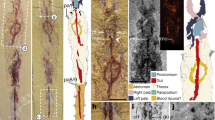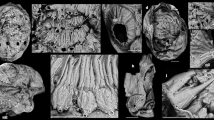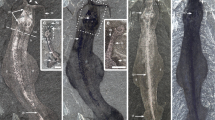Abstract
Palaeozoic invertebrate fossils may pose severe problems in assigning them to Recent taxa. Sutton et al.1 describe the beautifully preserved and illustrated Silurian fossil Acaenoplax hayae as a “plated aplacophoran” mollusc, interpreting its polychaete-like characters as convergent features. In our opinion, it is more parsimonious to place this organism in the Polychaeta, as the molluscan similarities are limited to serial valve-like structures, suggesting polyplacophoran affinities. It is unlikely that Acaenoplax represents a primitive organization that is neither molluscan nor polychaete — instead, it appears to represent a highly derived, specialized line of invertebrate evolution.
This is a preview of subscription content, access via your institution
Access options
Subscribe to this journal
Receive 51 print issues and online access
$199.00 per year
only $3.90 per issue
Buy this article
- Purchase on Springer Link
- Instant access to full article PDF
Prices may be subject to local taxes which are calculated during checkout

Similar content being viewed by others
References
Sutton, M. D., Briggs, D. E. G., Siveter, D. J. & Siveter, D. J. Nature 410, 461–463 (2001).
Salvini-Plawen, L. Malacologia 19, 249–278 (1980).
Salvini-Plawen, L. Iberus 9, 1–33 (1990).
Runnegar, B. & Pojeta, J. Jr in The Mollusca Vol. 10 (eds Trueman, E. R. & Clarke, M. R.) 1–57 (Academic, Orlando, 1985).
Cherns, L. Palaeontology 41, 939–974 (1998).
Fauchald, K. & Rouse, G. W. Zool. Scripta 26, 71–138 (1997).
Rouse, G. W. & Fauchald, K. Zool. Scripta 26, 139–204 (1997).
Hartmann-Schröder, G. in Die Tierwelt Deutschlands 58 2nd edn, 1–594 (Fischer, Jena, 1996).
Banse, K. & Riedl, R. in Fauna und Flora des Mittelmeeres (ed. Riedl, R.) 391–423 (Parey, Hamburg and Berlin,1983).
Author information
Authors and Affiliations
Corresponding author
Rights and permissions
About this article
Cite this article
Steiner, G., Salvini-Plawen, L. Acaenoplax — polychaete or mollusc?. Nature 414, 601–602 (2001). https://doi.org/10.1038/414601a
Issue Date:
DOI: https://doi.org/10.1038/414601a
This article is cited by
Comments
By submitting a comment you agree to abide by our Terms and Community Guidelines. If you find something abusive or that does not comply with our terms or guidelines please flag it as inappropriate.



